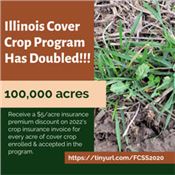Incentives Added For Cover Crop Planting

ERIN WUNDERLICH
URBANA, ILLINOIS
Cover crops are an effective in-field management strategy to stem the loss of both nitrate-nitrogen and total phosphorus from corn-soybean fields, yet less than 6 percent of Illinois’ cropland is planted to cover crops annually. To meet the water quality goals of the Illinois Nutrient Loss Reduction Strategy, 35 percent to 75 percent of Illinois’ cropland will need to be protected by cover crops, depending on the suite of conservation practices implemented.
"Cover crops can improve the resiliency of Illinois farm operations by preventing erosion and improving the ability of many soil types to absorb water that will later be available for cash crops," says Talon Becker, Illinois Extension commercial agriculture educator. “As we face the production and sustainability challenges of the 21st century, farmers attempting, then adopting practices that aim to improve the 'health', resiliency, and productivity of their soil is in everyone's best interest.”
In addition to the on-farm benefits of improved soil function and health, cover crops also enhance environmental quality, providing multiple benefits to Illinois communities. "Because cover crops can improve the resiliency of soil, there is potential to reduce yield variation from year to year, meaning there may be fewer insurance claims over time," says Becker.
A number of possible scenarios for reaching nutrient loss reduction goals, all of which included cover crops, were outlined in the most recent Nutrient Loss Reduction Strategy Biennial Report.
"According to those estimates, we need over 6 million acres of cover crops to meet short-term nutrient loss reduction goals,” says Becker.
“Illinois currently has about 1.4 million acres of cover cropped land, meaning we still have a long way to go with cover crop adoption to reach our goals. Incentive programs like this can help us to build the momentum of cover crop adoption and assist in reaching those goals."
A new premium discount program offers assistance to farmers who plant cover crops on acres installed outside of state and federal program incentives, such as EQIP, CSP and state cost share. American Farmland Trust is leading a coalition of partners in Illinois to offer the Fall Covers for Spring Savings.
University of Illinois Extension, as part of the Illinois Sustainable Ag Partnership, says each eligible applicant receives a $5 per acre insurance premium discount on the following year’s crop insurance invoice for every acre of cover crop enrolled and accepted in the program. Interested applicants can find more information at: tinyurl.com/FCSS2020.
Illinois Department of Agriculture has shown enthusiastic support for this program which follows the model of the Iowa Department of Agriculture and Land Stewardship’s crop insurance demonstration pilot.
Funding for FCSS programs in the IDOA budget doubled in 2022 to $600,000 or 100,000 acres. More than 500 farmers applied in 2020 and 750 in 2021, demonstrating the increasing popularity of the FCSS program.
In addition to the state incentive, 600,000 FSA certified cover crop acres were eligible for an additional crop insurance discount. This acreage received an additional $5 per acre through the USDA Pandemic Relief Program.
NRDC originally came up with the idea of state-funded crop insurance incentives, and has been collaborating with local partners in different states (starting in Iowa) to encourage crop insurance pilot programs.
“Our partners in Illinois put a lot of hard work into advocating for the FCSS program and ensuring that Illinois farmers have this additional incentive to improve soil health on their farms,” says Becker.
This program and level funding for Illinois conservation districts is good news in tough times. Tariffs, years of declining commodity prices, and volatile weather conditions driven by climate change have all taken a toll in farm country. Any support for conservation can help ensure that soil erosion and water quality doesn’t go from bad to worse and that farmers are set up for success through better soil health.
To apply
Applications open on a first-come-first-serve basis on Dec. 15 and must be completed in full for eligibility. Those who need assistance in applying for this program can consult their local SWCD office OR the Illinois Department of Agriculture (IDOA).
Individuals must certify fall planted cover crops with the FSA office using the FSA 578 form. IDOA will verify applications and respective acreage. IDOA may contact applicants for additional clarifying information. Applicants must maintain documentation on cover crops that have been seeded (e.g., seed bills) and utilize Midwest Cover Crop Council – Cover Crop Tool recommendations. To ensure the practice achieves the desired results, no full width tillage/ termination of the cover crop in the fall is allowed. American Farmland Trust led the effort to get this program over the finish line, working with Illinois Corn Growers, Illinois Stewardship Alliance, the Association of Soil & Water Conservation Districts, The Nature Conservancy, Delta Institute, Prairie Rivers Network, the Izaak Walton League, Illinois Environmental Council and, lthe Illinois Department of Agriculture and USDA’s Risk Management Agency.
The Midwest Cover Crop Council provides information on alternative cover crop species, says Becker, including species, rate, date, and termination recommendations. ∆
Content supplied by the University of Illinois Extension